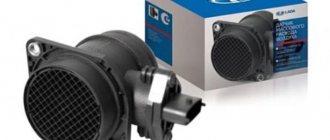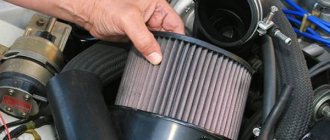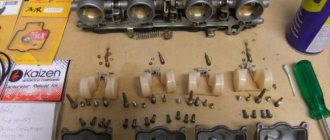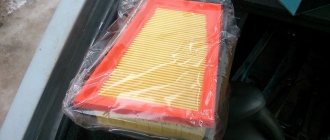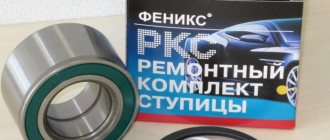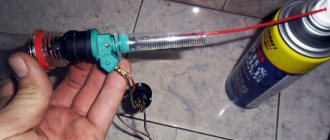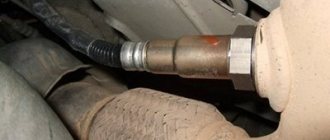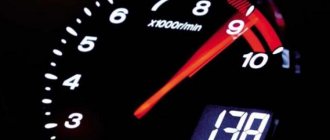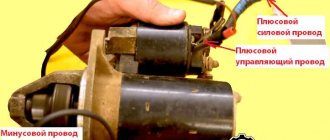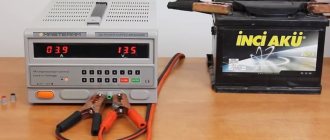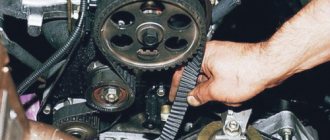The mass air flow sensor is a device without which normal engine operation is impossible. The performance of the mass air flow sensor directly affects the functionality of the power unit. How to determine if the flow meter is faulty and how to clean the mass air flow sensor - you can find the answers to these questions below.
Possible malfunctions of the mass air flow sensor: signs and causes
How to clean and rinse the mass air flow sensor? We will talk about this below, but first, let's look at the signs and causes of device malfunction. The parameters transmitted by the flow meter largely influence the formation of a combustible mixture, which is very important for any modern engine. If the device fails, this may also make it impossible to start the engine.
By what symptoms can you understand that it is time to change or clean the regulator:
- the appearance of the Check Engine indicator on the control panel;
- the fuel consumption of the car has increased;
- The power of the vehicle has decreased significantly; the car now needs more time to gain speed;
- the dynamics dropped, in particular when accelerating;
- the engine does not start, it is possible to start the power unit with great difficulty;
- If the car is idling or stopped at a traffic light, then the crankshaft speed may fluctuate.
As for the causes of the malfunction, there are several of them:
- The flow meter is clogged, this is quite normal, in this case you can wash it.
- The device is faulty; only replacement will solve the problem.
- Poor contact of the mass air flow sensor with the on-board network; this may be caused by damaged wiring.
Naturally, such symptoms of a breakdown may also indicate a malfunction of other systems and devices, which is why every car owner should be able to diagnose problems.
Causes of failure
Now let’s talk about what causes the breakdown of this device. Before cleaning the mass air flow sensor, you need to make sure that it is really to blame for this engine behavior. Breakdowns can occur for the following reasons:
- The active part of the sensor is clogged. In principle, this is a normal phenomenon; regular washing can solve all problems.
- Complete failure of the device. In this case, only a complete replacement of the element will help.
- Destruction of the wiring, as a result of which the sensor is not connected to the control unit and power supply.
It is worth paying attention to the fact that the symptoms of malfunctions listed above may also indicate breakdowns of other systems and mechanisms. Therefore, before carrying out repairs, it is necessary to correctly identify which unit has a malfunction.
Sensor diagnostics
There are several ways to test the performance of a flow meter; let’s consider the easiest and fastest one. To carry out diagnostics, you will need to disconnect the power connector from the mass air flow sensor, but the engine must be running. When the contact is disconnected, the control unit will begin to operate in emergency mode. Accordingly, as a result of this, the fuel dosage will be carried out according to the parameters that were received from the throttle.
It must be taken into account that in this case the speed of the power unit can increase sharply to 1500 per minute. However, this does not happen in all cars. With the flow meter turned off, you need to drive the car a little. If you notice that the performance of the power supply has improved, then most likely you need to change the mass air flow sensor (video author - Xie Dan).
Is it possible to clean the air flow sensor with carburetor cleaner?
It is not recommended to use carburetor cleaners for electronic sensors! The chemicals contained in these products can cause irreversible damage to sensitive elements. However, the use of such compositions for cleaning mechanical flow meters is not excluded. However, here too it is better to use specialized substances, for example, budget cleaners offered by the Kerry brand.
It is necessary to warn owners of cars equipped with similar sensors against other errors:
- Cleaning with more active solvents: this may cause deformation of the plastic parts of the sensor itself and its housing.
- Using cleaner brands not recommended by the vehicle manufacturer.
- Cleaning the mass air flow sensor with products that are used to clean the throttle body.
- Reinstall the unit that has not dried after treatment.
A clean sensor can restore 4 to 10 horsepower to the car, which is well worth the time and expense of cleaning. It is recommended to perform such prevention once a year.
Source
Purifier selection options
How to clean the flow meter? The modern market offers many products for cleaning regulators; let’s look at the most effective options:
- Liqui Moly. This manufacturer, as you know, produces not only cleaning products, but also motor and transmission oils, as well as other types of liquids. If you believe the official information provided by the manufacturer, then this product belongs to the high-quality category. Accordingly, the cost of such a MAF cleaner will also be high. In fact, Liqui Moly cleaners cope with their tasks quite effectively - this product perfectly removes dirt from the sensor. If the flow meter was in working order at the time of cleaning, then after that it will work for a long time. The use of Liqui Moly is relevant in both gasoline engines and diesel power units.
- Alternatively, you can use alcohol to clean the device. This method is considered one of the oldest, but nevertheless the most effective. Due to its chemical properties, alcohol is good at removing clogs that accumulate on the sensitive component of the air flow sensor. Despite its effectiveness, today this method is not used so often and is usually used by unscrupulous technicians at service stations. The client pays for a special substance, for example, Liqui Moly, and in fact the cleaning is carried out using alcohol.
- The next option is fluid for carburetor engines. This option is considered one of the most effective and frequently used. Using carburetor fluid, you can effectively clean it, and as practice shows, such a product allows you to remove all contaminants.
- Another product sold in spray form is Liquid Key. This cleaner is used to remove all kinds of contaminants, not only from the flow meter, but also from other mechanisms and components.
- A universal tool for performing many tasks is WD-40. This liquid is used by our compatriots to clean all kinds of components, remove rust, get rid of squeaks, etc. Not so long ago, our car enthusiasts began to use it to clean flow meters (the author of the video is the Gen channel MB W140 Germany).
Which cleaner should you choose?
If you decide to clean the mass air flow sensor yourself, you need to choose the right product:
- Liqui Moly. To clean the regulator, you can use Liqui Moly liquid. Liqui Moly is known for all its automotive products. Products from the manufacturer Liqui Moly are characterized by high quality, as well as a considerable price. The liquid mass air flow sensor cleaner Liqui Moly is an effective product in practice. As practice and reviews from car enthusiasts show, Liqui Moly allows you to effectively get rid of contaminants and if the air sensor is in working condition, after cleaning it can work for a long time. This product is suitable for both petrol and diesel units. The cost of Liqui Moly today is about 12 USD. e.
- Alcohol. You can clean the air sensor the old fashioned way - using alcohol. Alcohol allows you to effectively break down dirt and blockages. The use of alcohol was relevant twenty years ago; today this method is rarely used. To deceive the car owner and bill him for flushing the regulator with a cleaning agent. This practice occurs frequently at our service stations.
- Liquid for cleaning carburetors. One cheap option to clean the device is to use carburetor cleaner. The cost of one cylinder is about 1.2 dollars. If you believe the reviews of car enthusiasts, this analogue is no less effective than Liqui Moly, while its cost is ten times lower.
- "Liquid Key" Also a domestic product, sold in the form of a spray. The product is intended to rid various vehicle components and assemblies of frozen contaminants.
- WD-40. Many motorists have such a tool. In practice, WD-40 has long shown its effectiveness, so many car enthusiasts use it for these purposes. It can also be used to clean the air sensor (video author - Pavel Ksenon).
Instructions for washing the mass air flow sensor
Cleaning the flow meter can be done in a garage; there is nothing complicated about it.
Depending on the car model, the procedure for removing the sensor can be carried out in different ways; consider an example of cleaning with a domestic “Ten”:
- First, you should turn off the ignition and, just in case, reset the battery terminal. Open the hood and find the mass air flow sensor, then disconnect the connector from it. There is a pipe connected to the flow meter; it must be disconnected. Using a wrench, you need to unscrew the screw that secures the device to the air filter, or rather, to its housing.
- The flow meter itself is removed from the corrugation; in the case of the “ten”, an asterisk wrench is required to dismantle the sensor. Use it to unscrew the screws and then remove the device from the seat.
- If, after removal, you notice that there is an oil deposit on the device, you will need to rid the case of this. Any product from those described above is suitable for cleansing. As practice shows, there is no fundamental difference between these means.
- On the sensitive element, usually made in the form of a film, there are several controllers; they are made in the form of a wire and mounted on resin. Using the same cleaning agent, you will need to carefully, not in abundance, spray it on the sensitive element. At this stage, you should act as carefully as possible, since there is a possibility of damage to the film. After the sensitive part has been treated, you need to wait a little until the product takes effect. If there is a lot of contamination, then it may make sense to repeat this procedure once or twice. In order to ensure faster evaporation of the substance, you can use a pump or compressor device. But keep in mind that too much pressure can destroy the sensitive component, so don't overdo it.
Photo gallery “How to clean yourself”
Price issue
The cost of Liqui Moly cleanser is currently about 700 rubles. A cheaper analogue, liquid for cleaning carburetors, will cost the buyer about 70-100 rubles. As for WD-40, the cost of a 100 ml can today will be approximately 180-220 rubles.
Liquid Moly cleaner
Now we will look at what cleaners can be used when washing the mass air flow sensor. Today there are a lot of products on the market that allow you to clean. The most effective can be called “Liqui Moly” from a manufacturer that produces transmission and motor oils, as well as other liquids. If you trust the official information provided by the manufacturer, the cleaner is of high quality.
Consequently, the price of such a solution will be quite high. According to experts, the Liquid Moly cleaner copes with the task very well. The product perfectly removes dirt and carbon deposits from the sensor. If the sensor was in working condition before cleaning, then using the product can significantly increase its service life.
Is it possible to clean the air flow sensor with carburetor cleaner?
It is not recommended to use carburetor cleaners for electronic sensors! The chemicals contained in these products can cause irreversible damage to sensitive elements. However, the use of such compositions for cleaning mechanical flow meters is not excluded. However, here too it is better to use specialized substances, for example, budget cleaners offered by the Kerry brand.
It is necessary to warn owners of cars equipped with similar sensors against other errors:
- Cleaning with more active solvents: this may cause deformation of the plastic parts of the sensor itself and its housing.
- Using cleaner brands not recommended by the vehicle manufacturer.
- Cleaning the mass air flow sensor with products that are used to clean the throttle body.
- Reinstall the unit that has not dried after treatment.
A clean sensor can restore 4 to 10 horsepower to the car, which is well worth the time and expense of cleaning. It is recommended to perform such prevention once a year.
Failure of the air flow sensor is a fairly common occurrence. But what can cause this, how to determine that the sensor is clogged, as well as how and how to clean the air sensor on a VAZ 2114 - we will look at it in this article.
What is the best way to flush the air flow sensor?
In fact, there are not many cleaning compounds that can be used to clean the air sensor - all the others will simply ruin it (see section above).
Therefore, the question: what is the best way to flush the air flow sensor can be answered quite specifically:
- pure medical ethyl alcohol that does not contain any impurities;
- carburetor cleaner (does not contain acetone);
- spray WD-40.
At the same time, medical alcohol can be used either 96 degrees or diluted with distilled water in a ratio of 1 to 5.
Examination
Checking the mass air flow sensor is carried out using a multimeter, diagnostic tool or oscilloscope. In most cases, car enthusiasts do not have equipment that can diagnose sensor failure.
In this case, let's consider checking with a regular multimeter, which almost every driver has or is otherwise inexpensive.
Checking the mass air flow sensor with a multimeter can only be done with a sensor that is installed on an engine without an E-GAS system. The frequency sensor installed in conjunction with the electronic throttle cannot be checked using a multimeter. Checking such a sensor is carried out with a diagnostic device using ADC channels or using a diagram on an oscilloscope.
You can also check the frequency sensor using the ELM327 diagnostic tool; read how to do this in our article.
Verification Process
To check the sensor you will need two needles and a multimeter. The principle of determining the performance of the mass air flow sensor is carried out by measuring the voltage between the contacts.
Checking the circuit
Initially, the sensor's power circuit is checked.
- We switch the multimeter to the DC voltage measuring mode at 20V.
- Remove the connector from the mass air flow sensor.
- Turn on the ignition on the car.
- We connect one of the multimeter leads to the motor housing, and the second to Pin No. 2 on the connector (there is a numbering of contacts on the block). The voltage at Pin No. 2 must be at least 12V.
- We carry out the same procedure with Conclusion No. 4. The voltage at Pin No. 4 must be at least 5V.
If the readings do not match and are significantly less than those indicated, you should check the battery, computer and power supply circuit of the mass air flow sensor.
Sensor check
Let's start checking the sensor; to do this, connect the mass air flow sensor connector if it is removed.
- We set the DC voltage measurement limit on the multimeter to 2V or 2000mV (in different versions of the multimeter, this value is indicated differently).
- We measure the voltage between terminals 1 and 3 with the car ignition on and off. We check the readings with the table below.
| Voltage (V) | State |
| 0.99…1.01 | Condition of the new sensor |
| 1.01…1.02 | The sensor is in good condition |
| 1.02…1.03 | Normal state of the air flow sensor |
| 1.03…1.04 | Needs replacement soon |
| 1.04…1.05 | The sensor practically does not work, it needs replacement |
| 1.05...and higher | The sensor is completely faulty and urgently needs replacement |
Also, one of the good checks of the mass air flow sensor is to replace it with a known good one, for example from another similar car.
